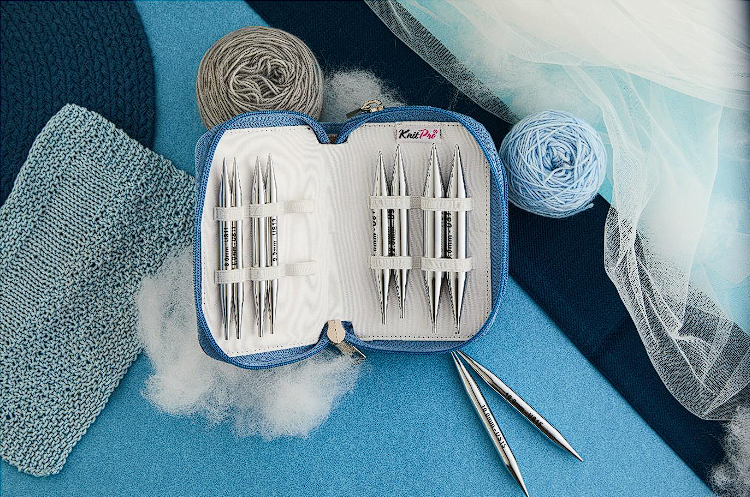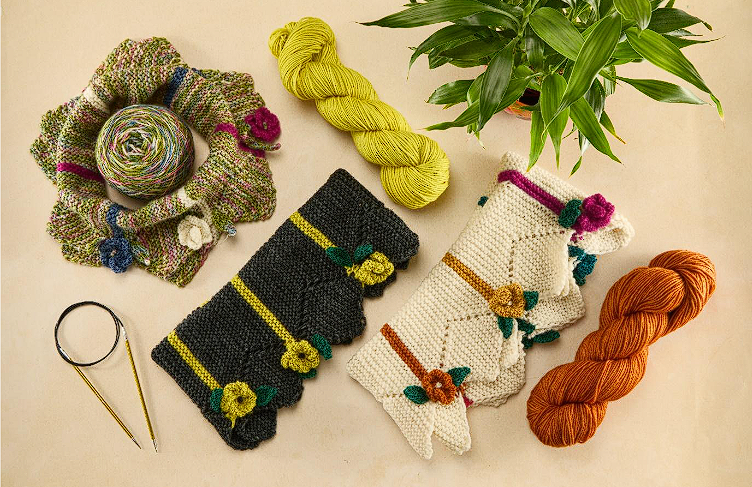The knit stitch is the foundation of the craft. It is the first stitch you learn with your knitting needles. Every knitted stitch pattern works with this fundamental stitch and its mirror version- the purl stitch. Though very basic, the knit stitch opens up endless possibilities with its variations. Knit 1 Below Stitch is easy to learn and even easier to include in your knitting projects. The name itself clarifies how you work the stitch. Whenever you learn to knit, you cast on stitches and are taught to go row-by-row or in rounds, but this knit-stitch variation asks you to work in a row/ round below. This step results in interesting textures that work for lace and colorwork patterns. Do you want to give it a try? Get your favorite knitting needles and yarn and work on a swatch.
If you are new to knitting or the knit one below stitch, we're here to guide you through every step in this blog, making the learning process a breeze. By the end, you'll be confident in mastering this exciting stitch technique.
Understanding the Knit One Below Stitch
A simple tweak to the knit stitch that makes an impact, The Knit One Below stitch is a technique that every knitter must learn and try in their projects. Abbreviated as K1B or k1b, the method works for knitting patterns to make lace designs, stretchy ribs, and other textures. When you knit stitches, you work on stitches that are on your knitting needle, generally the left hand, if you are right-handed. However, k1b means working the knit stitch by inserting the needle in the row below. In fact, you can go many (around 3-4) rows below.
Generally, knitting below a stitch in the active row or round results in an unraveled mess. However, with care and precision, this technique can be a simple yet fantastic way to enhance your knitted fabric. Like the pattern of knit stitches, a fabric made of the knit one below method is also reversible. Another thing that you must keep in mind is that you can correct a wrong K1B by following the steps to fix a dropped stitch in knitting with a repair hook.
How to Knit the Knit 1 Below Stitch

If you are working on a practice swatch, you can choose knitting needles that fit your preferences. But, if you are working on a pattern, select the needles mentioned in the instructions. For a project, knit back and forth; for example, a lace-knit shawl or scarf, single-pointed needles will do, or you can work with circular knitting needles. For projects knit in the round such as a pair of socks, you can work with double-pointed needles (DPNs) or circulars for a regular knit pattern or the magic loop technique.
For a practice swatch, cast stitches on a knitting needle and work on two or three rows. Or, if you are working on a pattern, work as instructed and once you reach the stitch you want to knit below, spot the stitch you'll work into.
Mark the stitch you want to knit.
Insert the working knitting needle tip into the stitch.
Wrap the yarn around the right needle as if to knit, and draw a loop through the stitch below.
Slip the stitch off the left needle.
You have knit one below.
You can continue the row/round by altering it with regular knit stitches. You can follow the same steps for the purl one below stitch (P1B) technique. If your patterns have multiple k1b, place a stitch marker to mark the repeats.
Once you have learned how to knit one below stitch, the next step is to understand where you can apply the stitch technique.
1. For Textures
K1B stitch technique creates a ribbed or ridged texture. It is not just attractive but also functional, adding extra stretchiness. You can apply the knit below stitch to a hat, socks, or sweater neckline and see a beautiful ribbed effect without having to work on purl stitches. K1b features in the beautifully textured Fishermen's Rib Stitch Pattern that produces a warm and thick fabric, an ancient stitch pattern for seafaring fishermen. The enhanced texture works with cables and attractive Celtic Knot designs.
2. For Colorwork Patterns
The simple tweak to the knit stitch results in interesting colorwork. Whenever you are working on two contrasting colors of yarn at the same time, you work with slip stitches, which, though functional, some knitters find result in tight stitches. So, to have added stretchiness without doing much, K1B comes handy. Plus, the effect is vertical rows of colors that have a beautiful effect.
3. For Design
K1B is generally unexplored for designs, with only a few patterns available. Knitting below a stitch creates interesting designs when combined with lace, cables, Celtic knots, and colorwork.
So, get ready to explore the knit one below stitch technique in your projects and see them transform!
Expand your knitting skills with tools and accessories that assist with crafting. Explore the KnitPro collection for a wide range of knitting needles. Choose a pair of single-pointed needles or a set of five double-pointed (DPNs) or circulars- fixed or interchangeable. A knitting needle set of interchangeable needles will assist you with multiple sizes in one place, allowing you to experiment with gauges and projects. For beginners, we've got bamboo knitting needles and sets to assist with a smooth crafting experience. Our laminated birchwood range of knitting needles comes in vibrant shades in regular and unique square J'adore Cubics and earthy colors of Ginger. Smooth metals include Zing, Nova, and our stainless-steel Mindful Collection, which are not just smooth but carry an inspirational word.












